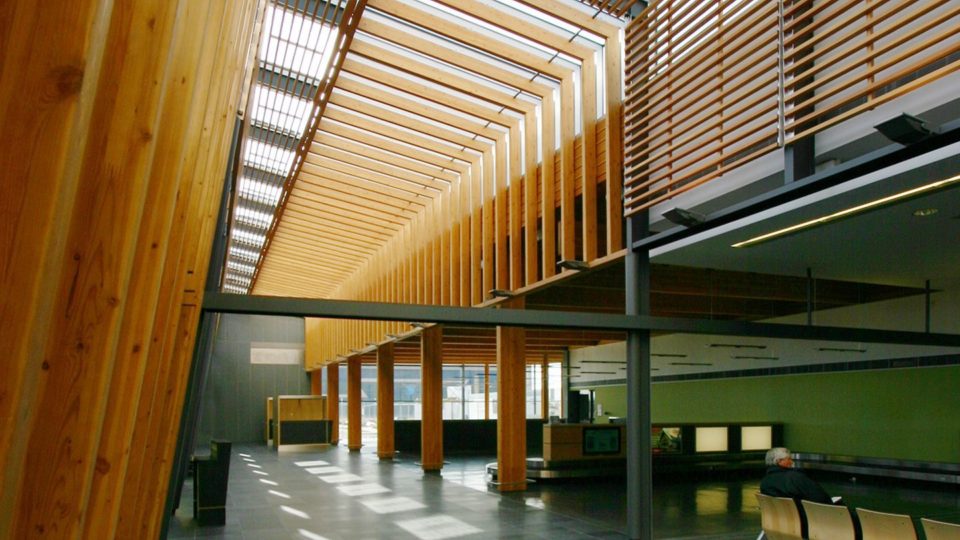- Be the global hub for expertise in low-carbon, GREEN building
- Invest In, And Protect, Our Working Forest Land Base
- Have Smart Rules That Protect The Environment And Encourage Investment
- Strengthen Participation Of Indigenous Peoples And Partnerships With Communities
- Double Down On Market And Product Diversification

Be the global hub for expertise iN low-carbon, GREEN building
The time is right to accelerate our reputation as world leaders in building with wood.
Our province has flagship projects such as the Brock Commons Tallwood House at the University of British Columbia, which – at the time of construction – was the tallest mass timber building in the world. We also have beautiful examples of wood construction in almost every corner of B.C., from Southern Okanagan Secondary School in Oliver to the Audain Art Museum in Whistler.
The B.C. government’s commitment to use B.C. wood in the construction of the new St. Paul’s Hospital in Vancouver and the modernization of the Royal B.C. Museum in Victoria will also advance the use of wood in high-profile public infrastructure. But there is more we can do. We still see an abundance of steel and concrete in our built environment and could make further strides to use our own B.C.-made wood products right here at home, avoiding U.S. duties and the cost of transportation.
This is not the time to be shy. We have an opportunity to show the world how it’s done by creating a centre of excellence to take our expertise to the next level.
We can be the “Harvard of Green Building”, the place the world looks to for the next big idea on how to use the resources that come from the forest, in a way that has a lighter climate impact than ever before.
We have the people, the resource, the know-how and the ability to lead the world. Let’s grab the opportunity.
CHOICES FOR A BETTER FUTURE:
Be the “HARVARD of Green Building”
- Make B.C. the global centre of excellence for green building. Bring together companies, technical and academic expertise, along with government to drive this initiative.
- Leverage and expand existing research into wood innovation and green building technology through a dedicated green building research fund, with multi-year financial contribution from industry.
- Create an “economic toolbox” to incent the growth and development of mass timber expertise.
- Establish a B.C. innovation incubator to support small businesses and entrepreneurs in advancing small scale research and commercialization of new products, wood design expertise and innovations like glues, hybrids, acoustic solutions, coatings and more.
- Establish a permanent Chair in Green Building at UBC and/or UNBC.
- Jointly fund and promote Timber Online Education - the Vancouver-based global non-profit resource for teaching safe, sustainable, and economical wood building design and construction. Use the platform to aggregate and share information and address questions on building techniques, fire safety, building codes, policy and market changes.
- Mandate B.C. trade representatives to identify opportunities to use B.C. wood in cutting edge projects, like Sidewalk Labs, the wood-built neighborhood along Toronto’s eastern waterfront. Capture the opportunities.
- Launch an industry competition – a B.C. Prize for Wood in Construction – with substantial prizes awarded to innovations that drive growth in forestry and the wood construction sector.
- Advance B.C.’s low-carbon economic advantage as outlined in the Memorandum of Understanding signed by the Government of British Columbia and the Business Council of British Columbia.
Promote building with low-carbon, B.C. wood in our own province
- Increase the use of B.C. wood in the province – commercial, public, and residential – by 20% over current levels within 5 years.
- Partner with BC Housing to use B.C. wood to build new mid-rise affordable housing of 5 to 12 storeys.
- Require all public sector building projects to consider using “wood first” to advance B.C.’s low-carbon economy and mitigate climate change.
- Put in place a financial incentive for private sector developers to use B.C. wood products.
- Maintain B.C.’s leadership in the development and adoption of building codes. B.C.’s early adoption of 5 to 6 storey mid-rise wood mixed use buildings and plans to be the first to adopt the 2020 National Building Code, including 12 storey wood buildings, has positioned B.C. as a design and construction leader. Ensure the Building Safety Standards Branch has experienced resources to facilitate early adoption and implementation of the 2020 code and other advancements of wood design and construction.
- Create dedicated “code liaison” representatives in the Government of B.C. who can assist architects and builders as they navigate the wood building code provisions.
- Undertake a public campaign to communicate benefits and encourage the use of wood and mass timber.

